|
Have a safe day!
Thursday, Aug. 11
2:30 p.m.
Theoretical Physics Seminar - Curia II
Speaker: Elizabeth Simmons, Michigan State University
Title: The Phenomenology of the Top Triangle Moose Model
3:30 p.m.
DIRECTOR'S COFFEE BREAK - 2nd Flr X-Over
THERE WILL BE NO ACCELERATOR PHYSICS AND TECHNOLOGY SEMINAR TODAY
Friday, Aug. 12
3:30 p.m.
DIRECTOR'S COFFEE BREAK - 2nd Flr X-Over
4 p.m.
Joint Experimental-Theoretical Physics Seminar - One West
Speakers: Maaike Limper, University of Iowa
Title: Latest Physics Results from ATLAS
Click here for NALCAL,
a weekly calendar with links to additional information.
Upcoming conferences |
|
Thursday, Aug. 10
- Breakfast: Apple sticks
- Minnesota wild rice w/ chicken
- Tuna melt on nine grain bread
- Smart cuisine: Italian meatloaf
- Chicken casserole
- Buffalo crispy chicken wrap
- Assorted sliced pizza
- Smart cuisine: Chicken pecan salad
Wilson Hall Cafe Menu
|
|
Friday, Aug. 12
Dinner
Closed
Wednesday, Aug. 17
Lunch
- Spicy sausage & cheese stuffed portobello mushrooms
- Spinach salad
- Strawberry mousse w/ cookies
Chez Leon Menu
Call x3524 to make your reservation. |
|
CMS reaches 100 publications
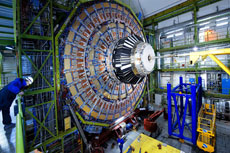 |
| The CMS detector produces a lot of data that physicists are publishing rapidly. Photo credit: Courtesy of CERN |
CMS published its 100th paper on Aug. 3. This accomplishment, unprecedented in its pace, came as a result of many things working together extremely well. Primarily, the performance of the LHC accelerator during the last two years was terrific. It exceeded all expectations by surpassing and even doubling the luminosity goal for 2011. We expect that by the end of the 2011 run, the LHC will deliver close to five times the luminosity of the 2011 goal.
The superb performance of the LHC, and, specifically, the CMS detector are primarily responsible for this milestone. By using a simulation program based on 30 years of physics, combined with our extensive use of test beams, we were able to understand the data almost as soon as it was produced. This, together with an enormous and well-coordinated analysis effort on many frontiers, manifested in the presentations of new preliminary results at the recent European Physical Society meeting in Grenoble, France. Many more new and updated analyses are expected in two weeks at the International Lepton-Photon conference in Mumbai, India.
To reach 100 papers, the review and publishing process must work smoothly as well. Physicists officially communicate the results of their experiments by publishing them in refereed journals. The review process beyond the physics group, which is an integral part of the analysis effort, includes an analysis review committee, a collaboration-wide review and, finally, a publication committee review and final reading. These steps, though costly in time and person power, are essential for making every effort to guarantee a correct and well-presented result. The process also provides an opportunity for every member of the collaboration to contribute.
All CMS papers, of which many already have tens of citations, are accessible via the CERN document server. Out of the 100 papers that CMS published so far, 75 are from LHC collision data, 24 are from the cosmic-ray runs of late 2009 and one is the CMS detector paper.
—Boaz Klima, deputy chair of the CMS publication committee
|
Vladimir Lobashev - Aug. 3
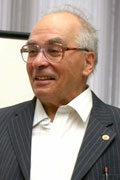 |
|
Vladimir Mikhailovich Lobashev
|
Editor's note: Yury Kolomensky, UC Berkeley, and Rashid Djilkibaev, INR, translated the following from the original Russian obituary.
World-renowned physicist Vladimir Mikhailovich Lobashev, 77, died on Aug. 3. He made outstanding contributions to nuclear and particle physics.
Professor Lobashev made seminal contributions to the measurements of parity and CP violation, to neutron and neutrino physics and to medium-energy nuclear physics. He first discovered and then made precise measurements of a previously unseen effect in quantum electrodynamics - rotation of the polarization plane of photons propagating through a polarized electron medium.
His measurements of several small parity-violating effects in nuclear reactions with polarized thermal neutrons were instrumental in establishing the universality of weak interactions. He led the groups that made some of the most precise measurements of the neutron electric dipole moment and neutron lifetime and set stringent constraints on the mass of the electron neutrino.
In the late 1950s, Lobashev dedicated his early scientific career to fundamental neutron physics at the St. Petersburg Nuclear Physics Institute of the Russian Academy of Sciences. It was there that he proposed a novel method of dealing with ultra-cold neutrons and obtained a limit on the neutron electric dipole moment, which was the best in the world at the time.
In 1972, he moved to the Institute for Nuclear Research of the Russian Academy of Sciences, Troitsk. During this time, Lobashev played a major role in designing the complex housing the intense beams of the Moscow Meson Factory.
He devoted his last years to the experiment Troitsk-NM, the precise measurement of the end-point spectrum in tritium beta decay. Troitsk-NM, together with a similar experiment at Mainz, set the best upper limit on the mass of the electron neutrino.
Lobashev was a co-inventor of the concept for the Mu2e experiment which will take place at Fermilab. He proposed a novel technique to capture muons at high-energy physics accelerators using graded magnetic solenoids and to produce intense muon beams. The applications of this technique may extend beyond Mu2e to the future designs of a high-energy muon collider.
Lobashev will always be remembered by numerous students and colleagues as a dedicated servant to science. He was highly respected by the scientific community in Russia and abroad.
Read more
|
Clever Apes #16: New dimensions
From WBEZ's Clever Apes Science Blog, Aug. 9, 2011
Do you ever get the feeling we’re all living in an illusion, man? And, like, what we see is really just a movie, you know, projected from the edge of the universe? And stuff? Hey, we out of Cheetos?
At some point, the line faded between adolescent/stoned/sci-fi speculation and high-order theoretical physics. The concept is this: All the stuff of the universe actually lives on a two-dimensional shell at its boundary. What we experience is a 3D holographic projection of that information. (And let me not be too flip – the theory is a product of very complex math that emerges from black hole physics. No bong hits involved, as far as I know.) If this idea sounds familiar to you, we did attempt to tackle it once before, in the very first episode of Clever Apes.
Read more
|
|
A top quark cautionary tale
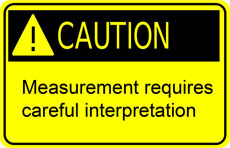 |
| Today’s measurement shows top quarks have a discernible preference for the direction in which they are created. |
The top quark, discovered at Fermilab in 1995, is the heaviest elementary particle known to date. By colliding protons and antiprotons to annihilate quarks and antiquarks in the beams, physicists can produce a top-antitop quark pair. Collisions similar to these produce light particles that are carefully studied, and their characteristics agree with the Standard Model. Does the Standard Model also accurately describe in detail collisions that produce top quarks?
On July 25, DZero announced the results of a study that examined the direction in which the top quark is produced. The specific question is whether or not the top quark favors production in the direction of the proton or antiproton beams.
DZero and CDF measured this quantity in the past and found disagreements with the Standard Model, but not enough to claim a discovery. Mostly, the problem is a small data set. In a small data set, things can happen that look odd, but really aren’t, like flipping a coin and getting four heads in a row. In this result, DZero analyzed five times as much data as earlier studies, and the scientists still found disagreements with the Standard Model. This supports the previous measurements and raises the possibility of a discovery.
Now we need to be careful. We compare our data to a calculation that begins with the Standard Model theory. However, the Standard Model equations are very difficult, and nobody knows how to use them to make exact calculations. So we make a series of approximations. The hope is that subsequent approximations add small and, eventually, negligible corrections. This technique is used in all particle physics calculations.
For this measurement, the first approximation predicts there should not be a preferred direction for this scattering, while subsequent approximations of the Standard Model do predict a favored direction. Several levels of approximations were made, however the most recent approximation still noticeably affects the prediction. It is possible that any discrepancies between data and theory reflect limitations in the approximations, rather than in the Standard Model itself.
This measurement is an excellent example of why scientists are cautious with their announcements. It also explains why progress is sometimes slow. Sometimes things aren’t what they appear to be. Still, this very challenging measurement could be an important hint of new physics, and ongoing work will continue to try to sort it all out.
—Don Lincoln
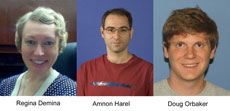 |
| These physicists from the University of Rochester performed this very delicate analysis. |
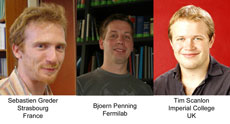 |
| Since top quarks decay essentially instantaneously, we detect the presence of their decay products. Top quarks decay 100 percent of the time into bottom quarks, so this measurement requires excellent bottom quark detection capabilities. These scientists head this effort for DZero. |
|
|